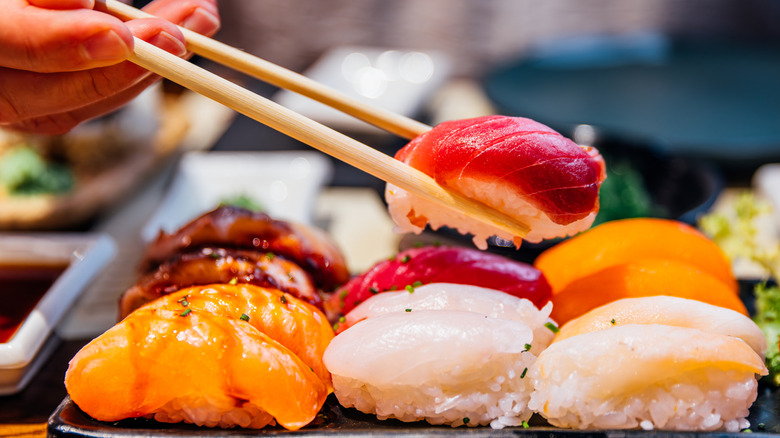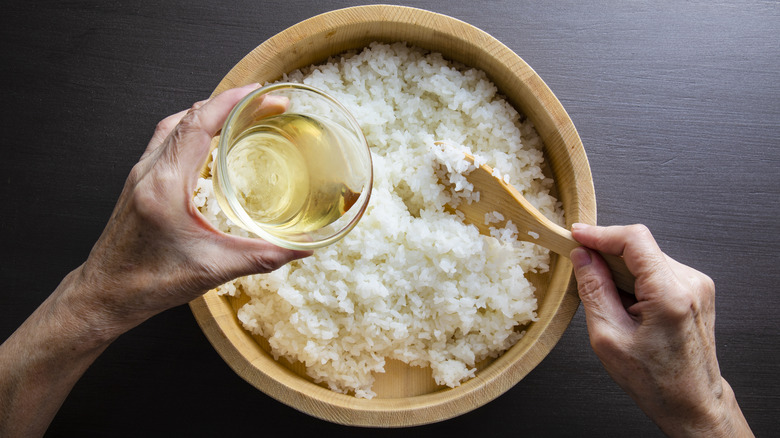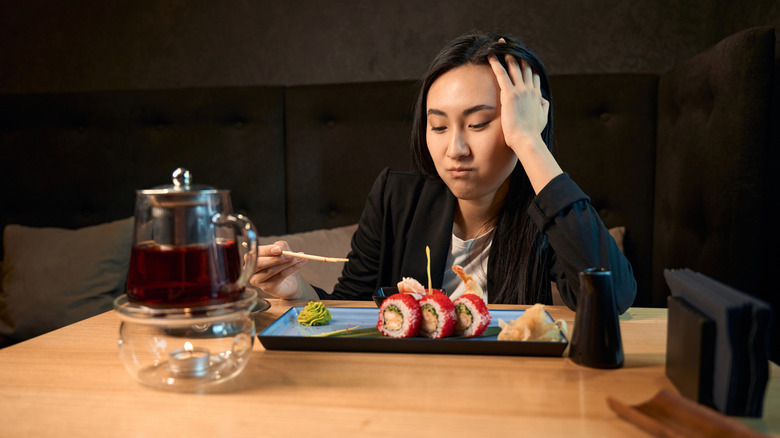The Rice Red Flag That Signals You're Eating At A Bad Sushi Restaurant
In its simplest form, sushi is a dish of only two parts — the rice (known as shari) and the topping (known as neta). Since the neta is often high-grade seafood, it's easy to see that as the star of the show — but in truth, the shari is equally important. In fact, bad rice is a massive red flag at a sushi restaurant because it not only affects the taste but could also indicate unsafe handling and storage. As chef-owner of Isekai Sushi and Cafe Christopher Stout told us in our article about sushi restaurant red flags, "Rice that looks clumpy and dry, or bloated and puffy, is a good indication that it's not cooked and/or taken care of correctly."
When you buy pre-made sushi at a supermarket, it's probably been sitting around in a refrigerator for at least a couple of hours. This is a necessary evil to keep the rice safe and edible — but that kind of cold, hard rice is something you should never experience in an actual sushi restaurant.
What does good sushi rice taste like?
Rice is always best when served as fresh as possible — and this is still true for sushi, even though it's not a hot food. When a quality sushi restaurant makes shari, the rice is cooked and immediately placed into a large, flat-bottomed wooden bowl called a hangiri. It's then a race against time to mix in the rice vinegar, salt, and sugar before the rice gets cold and starts to get too sticky. Once everything is mixed in, it's cooled with a fan until it's around 140 degrees Fahrenheit. By the time it lands on your plate, there should still be some faint warmth left in the rice — and it definitely shouldn't have been anywhere near a fridge.
Sushi chefs are also careful not to put too much pressure on the rice when they shape it. The grains should naturally stick together without too much help, and they should naturally fall apart again when you eat them. This means you should be able to feel the separate grains in your mouth as you eat. This texture is quickly ruined if the rice is squeezed too hard, left out for too long, or kept in a refrigerator.
As for the taste, you should be getting a good balance of sweetness from the sugar and tartness from the vinegar. These flavors will fade over time — which is why old or badly handled rice will end up feeling flavorless.
Can rice at a bad sushi restaurant be dangerous?
Rice is a staple food eaten all around the world in various different forms. It's incredibly versatile but once it's been cooked, it can be a little bit tricky to store. The main problem is a type of bacteria called Bacillus cereus, which can cause food poisoning.
These bacteria can survive the cooking process and if you don't eat the rice right away, it needs to be cooled down quickly and refrigerated to stop the bacteria growing to dangerous levels. So, if the rice at your sushi restaurant is bad because it's very cold, that means it's probably been refrigerated. While not ideal for your culinary experience, this should at least mean the rice was handled safely.
However, if your rice is bad because it's started to dry out and harden but it's not colder than room temperature, the safest thing to do is stop eating. When the rice doesn't taste fresh but also doesn't feel refrigerated, there's a chance that it's just been left out on the counter. This doesn't guarantee that you'll get food poisoning, but it's definitely not worth taking the chance.
When a restaurant is lazily refrigerating its sushi or breaking food safety rules by leaving food out for too long, it's a major red flag. You never know what other corners they might be cutting and, more importantly, you deserve the best sushi experience you can get. So forget about that place and find somewhere better!


